- Home
- Editorial
- News
- Practice Guidelines
- Anesthesiology Guidelines
- Cancer Guidelines
- Cardiac Sciences Guidelines
- Critical Care Guidelines
- Dentistry Guidelines
- Dermatology Guidelines
- Diabetes and Endo Guidelines
- Diagnostics Guidelines
- ENT Guidelines
- Featured Practice Guidelines
- Gastroenterology Guidelines
- Geriatrics Guidelines
- Medicine Guidelines
- Nephrology Guidelines
- Neurosciences Guidelines
- Obs and Gynae Guidelines
- Ophthalmology Guidelines
- Orthopaedics Guidelines
- Paediatrics Guidelines
- Psychiatry Guidelines
- Pulmonology Guidelines
- Radiology Guidelines
- Surgery Guidelines
- Urology Guidelines
Methylene Blue quickly kills malaria-parasites if added to antimalarials

The researchers of Radboud university medical centre have for the first time investigated the effect of methylene blue on the spread of malaria amongst humans and have found that it is a safe antimalarial that kills malaria parasites at an unprecedented rate. Methylene Blue quickly kills malaria-parasites if added to antimalarials and ensures that patients no longer infected other mosquitos, within as little as 48 hours.The patients are cured of the disease within two days, and they no longer transmit the parasite when bitten again by a mosquito. The results have been published in The Lancet Infectious Diseases .
The pressure is on when it comes to antimalarial medicines, as malaria parasites are increasingly resistant to the artemisinin-based combination therapies that are currently used. In addition, these medicines do very little to stop the spread of malaria, as the parasites remain in the blood for a long time, with the chance that other mosquitos are infected if they feed on the patient. The parasites split into the patient's red blood cells, forming male and female sex cells (gametocytes). If another mosquito bites the patient, it sucks up the sex cells and these are fertilized in the mosquito's stomach. The offspring then find their way to the mosquito's salivary glands, where the cycle starts again.
Effect after just 48 hours
The gametocytes can stay in a person's body for several weeks following treatment for malaria. In the new study in Mali, Radboudumc researchers added methylene blue to the artemisinin-based combination therapy. Methylene blue is a blue dye that is used in laboratories to distinguish dead cells from living cells. Adding the dye to the antimalaria medicine ensured that patients no longer infected other mosquitos, within as little as 48 hours. Patients who were not given methylene blue were able to infect other mosquitos for at least a week. Researcher Teun Bousema (Radboudumc) coordinated the study which was conducted together with the University of California (UCSF) and the Malaria Research and Training Center (MRTC). Bousema: "We noted that the male parasites disappeared from the bloodstream more quickly than the female parasites."
Blue urine
Encouraged by the promising results of laboratory experiments, Bousema's team has investigated for the first time the effect of methylene blue on the spread of malaria amongst humans. Bousema: "Methylene blue is very promising because it can prevent the spread of malaria within such a short time following treatment. There are also indications that methylene blue also works well in species that are resistant to certain medicines." The dye is safe and was tolerated well by patients. There is however just one awkward side effect: "I have used it myself, and it turns your urine bright blue. This is something that we need to solve because it could stop people from using it."
Malaria causes 430?000 deaths every year. Infection is caused by the bite of a malaria-carrying mosquito, and 90% of all deaths are in Africa, mostly amongst children. Malaria prevention focuses primarily on the use of mosquito nets, insecticides and medicine and, as a result, the number of deaths due to malaria has almost halved in the last ten years.

Disclaimer: This site is primarily intended for healthcare professionals. Any content/information on this website does not replace the advice of medical and/or health professionals and should not be construed as medical/diagnostic advice/endorsement or prescription. Use of this site is subject to our terms of use, privacy policy, advertisement policy. © 2020 Minerva Medical Treatment Pvt Ltd